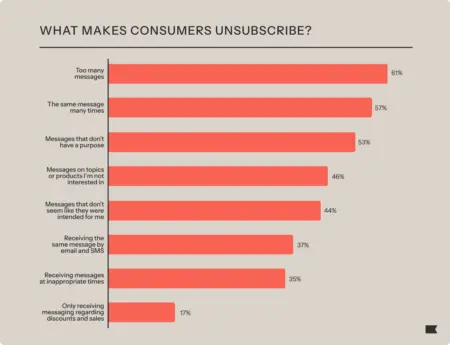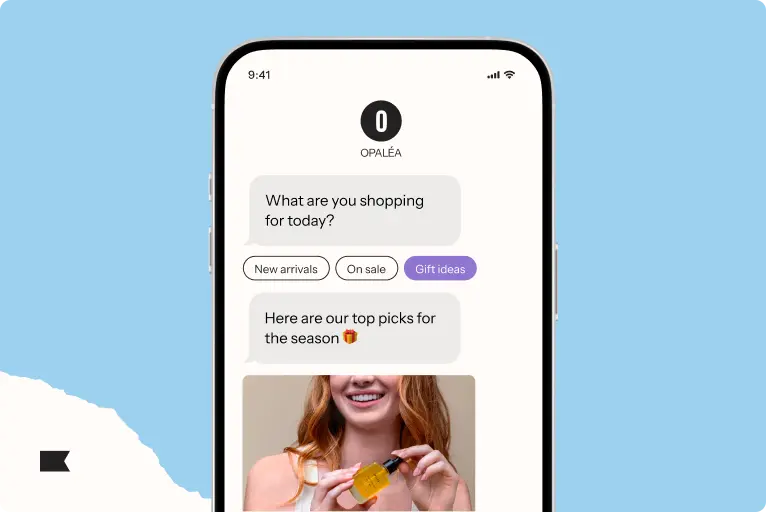How to create an effective SMS marketing campaign in 9 steps

Texting is personal, and it comes with a ton of unspoken social etiquette.
Conventions for texting vary by generation, culture, and person—take a peek at any family group chat and you might find yourself cringing at a string of questionable news links, inappropriate gifs, or novel-length messages.
We still don’t use text messaging perfectly amongst ourselves, so it’s no wonder brands had to go through a particularly awkward teen phase with SMS. And SMS marketing campaigns, in particular, are easy to get wrong.
When Klaviyo asked consumers what kinds of messages make them unsubscribe from SMS marketing, 61% said receiving too many messages, period; 57% said receiving the same message too many times; and 53% said receiving texts that “don’t have a purpose.”

Notice a common thread? The content of your SMS marketing campaigns should be timely—and it should also be meaningful.
Unlike an SMS marketing automation, which is triggered by a subscriber’s actions and therefore inherently tailored to the individual, an SMS marketing campaign is a one-time text message or series of text messages your brand sends to a list or segment of subscribers—to promote products or sales, or to otherwise deepen your relationship with your audience.
Any company that hasn’t dipped their toe into SMS should know: it’s an effective way to drive engagement, increase sales, and build customer loyalty.
If you want to learn from other brands’ mistakes with SMS marketing campaigns and get straight to the good stuff, you’ve come to the right place. Here are 9 essential steps for developing a successful SMS marketing campaign.
1. Define your campaign objectives
Never make the mistake of viewing SMS as a filler channel, cautions Melissa Matusky, manager and implementation consultant at Klaviyo. It needs to work in concert with your email marketing campaigns, not against them.
“You really need to be strategic,” she says. “It shouldn’t just be like, ‘I need to plug a gap—I don’t have an email today, so I’m gonna send an SMS.’ It’s really thinking about, ‘What am I planning here, and what am I trying to accomplish?’”
The answer, of course, should address your own business goals—you might be sending an SMS marketing campaign to:
- Raise brand awareness.
- Strengthen customer retention among VIPs, with special perks like early access or exclusive offers.
- Promote a sale.
- Announce a new product.
- Move inventory.
But considering 53% of consumers will unsubscribe from SMS after receiving messages that “don’t have a purpose,” the answer should also address the needs of your subscribers.
“You’re asking for your customer’s time and attention—to stop what they’re doing and take notice of your SMS,” says Kate Massey, head of APAC at Searchspring. “Every SMS, therefore, needs to enhance the customer’s shopping experience.”
In other words, the best SMS campaign a brand can send is a valuable one. Don’t bother someone on their phone unless yours fits that description.
“The brands that do SMS marketing well are brands that are reserving text for their most important messages,” says Jacob Sappington, head of email at ecommerce growth marketing agency Homestead Studio. “Brands that are willing to wait for the right moment to send a text often see that those messages tend to be really impactful.”
2. Know your audience—and make it clear you do
Returning to our unsubscribe graph, over half of consumers will unsubscribe from SMS if they receive too many messages on topics or products they’re not interested in—and half will unsubscribe if they receive messages that don’t seem like they were intended for them.
By contrast, when we asked what kinds of SMS messages from brands they most enjoy receiving, consumers identified shipment and delivery confirmation (51%), coupons or promotional codes (42%), and order confirmation (39%).

More plainly: Consumers want more personalized SMS marketing campaigns from brands.
For Blair Peterson, VP of strategy at ethical jewelry brand and Klaviyo SMS customer Dana Rebecca Designs, personalization is about “meeting the customer where they want to be met, vs. giving them broad information. I always say, our job is to message to the customer what they want based on what we know, before they fully know that it’s what they want.”
That’s exactly why Peterson spends most of her time in Klaviyo on segmentation.
“Klaviyo provides tremendous opportunity and tools to understand the customer, where they’re spending time, and what emails or SMS drive their interest,” Peterson explains. “It helps us make sure we’re creating tailored marketing that feels very personalized.”
Depending on what you’re trying to accomplish with it, consider catering your next SMS marketing campaign to one of these SMS segments:
- All SMS subscribers: everyone who has opted in to your SMS communication
- Highly engaged SMS: subscribers who are regularly opening and engaging with your text messages
- SMS engagement tracks: e.g., 30–90 day engaged or newly subscribed, 91–150-day engaged, etc.
- Prefers SMS: subscribers who prefer SMS over email
- VIP SMS subscribers: subscribers who spend the most money, order most frequently, or meet some other similar threshold
- High-intent SMS shoppers: subscribers who have begun a check-out at least once in the last 5 days but haven’t finished a purchase
- SMS location-based: subscribers who live in certain places
- SMS win-back: subscribers who have decreased their engagement
Ben Zettler, founder of Zettler Digital, recommends focusing on the highly engaged segment. “Subscribers who have specifically clicked on SMS at a certain frequency, or those who’ve completed a specific on-site action like browsing a product or adding something to a cart and then leaving it before completing their purchase, can be a great group to send to,” he says. “Because they’re so engaged, segments of this nature tend to drive high rates of return.”
3. Craft compelling, direct content that makes sense for SMS
According to our survey, 39% of consumers will unsubscribe from SMS after receiving “the same message by email and SMS.”
“SMS can’t be the same wording as email, and it shouldn’t be sent at the same time,” says Elliot Scott, founder and CEO of London-based retention agency ElliotDigital. “It’s a whole new angle—a whole new channel with different touchpoints.”
In email, longer-form, visual, narrative content is appropriate for the channel. But being direct—“kind of quick and punchy,” Sappington says—is “the biggest thing for SMS content.”
At Dana Rebecca Designs, a tone that’s “maybe more cheeky and relatable” works better in SMS campaigns than email campaigns, Peterson says. Homestead has run A/B tests to evaluate direct vs. indirect language, and has found that “when you try to be a little bit too flowery, you just lose people,” Sappington explains.
“Whenever we’re much more front and center about the offer or the reason why we’re texting, we tend to have better click rates, better conversion rates, and better revenue per message,” Sappington adds.
Massey agrees that to optimize SMS campaign click rates, you need to be “short and sharp” and “make your copy shine.” For example, “if you’re promoting a specific product, you’ll want to quickly give shoppers a sense of what it offers and how it fits their needs. If you’re promoting a campaign, make every character count to build excitement.”
A few other SMS best practices for marketing campaign content:
- Use emojis and MMS wisely. Data suggests they have minimal impact on performance, but they tend to be more expensive. Always test.
- Include one clear CTA.
- Use the link shortener provided by your SMS marketing platform. (Using a third party like Bitly can result in spam flags.)
- Link to a logical, actionable landing page.
- Use a customer relationship management tool. This will help you integrate your SMS campaigns with all your other campaigns and service across channels.
4. Whenever possible, offer something special
We’ve seen what makes people unsubscribe from SMS marketing. But what makes someone subscribe in the first place?
According to our survey, nearly half of consumers opt in to text message marketing because they purchase from the brand frequently, or because they simply love the brand—which is a big reason why Cassie Benjamin, email/SMS channel manager at Tadpull, thinks of SMS marketing programs as VIP and loyalty initiatives.

It’s important to remember that the VIP strategy is additive—meaning, you don’t reserve SMS purely for communications around exclusives or loyalty initiatives. You still want to promote your big sales and announcements to your SMS subscribers, too, because you know they’re engaged with your brand.
But when a customer gives you their phone number, “they’re trading you something really valuable—direct access to a text notification they will most definitely see,” Benjamin explains. “Make sure you’re providing value back to those customers.”
Exclusivity is why Ohio apparel brand HOMAGE was able to drive such incredible performance with their first SMS campaign on Klaviyo. After releasing a hype video encouraging customers to opt in to SMS to be first in line for a new product drop, HOMAGE used text messaging to share exclusive updates about the drop—including the link to buy first when the time came.
The campaign drummed up over 100 orders in the first hour alone. Ultimately, 86.9% of SMS subscribers clicked the in-message link, and 9% of fans placed an order—and the campaign delivered $167 in revenue per recipient.
“Klaviyo unlocked for us the modern way to shop,” says Nathan Okuley, VP of brand marketing at HOMAGE. “There was a feeling and a rush for customers to have access to something and in such a simple way. This changes the way we think about product dropping and releasing cool things and getting people excited about it.”
5. Send your SMS campaign at the right time
Remember, 35% of consumers will opt out of SMS marketing if they receive messages at “inappropriate times”—which makes this step a particularly important one.
For SMS flows, Klaviyo has a quiet hours feature that helps you make sure you’re not sending text messages to consumers during mandated no-contact times—by default in Klaviyo, 8 p.m. to 11 a.m. in the recipient’s local time zone.
In order to determine which day of the week and what time of day results in the highest engagement and revenue for your brand’s SMS marketing campaigns, always A/B test (more on that later), and avoid sending during quiet hours in the recipient’s local time zone.
“Be strategic about what time you send SMS campaigns,” suggests Alex Klein, VP of consumer engagement at 85SIXTY. “Many brands leverage an email strategy of sending at the same time on the same day of every week, but SMS performs better when you can hit the user at a moment in time you know they are likely looking at their phone.”
6. Determine your KPIs and continually measure success
Before you start digging into SMS campaign KPIs, remember that open rate is a vanity metric in SMS because most people read their texts just to get rid of the notification on their mobile device. “You want to know people are not only looking at your texts, but engaging with them,” Matusky points out.
Instead of open rate, experts recommend paying attention to engagement metrics like:
- Click rate
- Conversion rate
- Revenue per recipient
- Delivery rate
- Subscribe rate
- Unsubscribe rate
Which KPIs matter the most? Well, that depends on what you’re trying to accomplish—not only with your SMS marketing strategy more broadly, but also with each individual SMS campaign. “It’s not the same for every send,” Peterson points out.
For example, “if it’s a new launch, I’m really focused on revenue. If it’s educational or emotional, then I just like to see that they’re clicking through to the site and we’re driving traffic. If it’s July, I’m probably sending more conversational-type texts than promotional texts, vs. in February, I’m more focused on driving traffic to the site.”
“Of course you always want revenue,” Peterson says. “But it’s important to look at the total picture.”
7. A/B test and adjust your approach on a regular basis
For many brands, SMS is “a new muscle to learn,” says Rob Hand, lead product marketing manager at Klaviyo. “It shouldn’t be something you put on the side and wait for, because you’re not going to get better at communicating and texting with your consumers by waiting.”
As SMS becomes a more and more common marketing channel for your competitors, “you need to practice and figure out what actually works,” Hand says.
With Klaviyo, it’s easy to A/B test your SMS marketing campaigns for variables like:
- Types of incentives
- Flowery vs. direct copy
- Copy length
- SMS vs. MMS
- Emojis vs. no emojis
- Link destination
- CTA language and placement
- Audience segments
- Message timing
“You need to test all possible avenues to see what moves the needle the most,” Scott says. “If you don’t, then in 3 months when you’ve hardly used it, you’ll turn around and say, ‘It’s not working.’ Well, it won’t work if you don’t use it.”
8. Do it again—more than you think you need to
“There’s a good chance that even if you think you’re sending ‘a lot’ of text messages, you are still not sending enough,” says Katherine Burlock, senior account strategist at &BAM.
The numbers prove it: In our survey, we found that 72% of consumers are willing to receive a text from a brand at least once a week—and 45% are willing to do so a few times a week.

“You never want to end up in a situation where someone’s receiving a text from you when they haven’t received one in 3 months,” Hand points out. “That’s going to seem a little out of the ordinary. They may not even remember why they subscribed, or that they subscribed in the first place.”
If you’re new to SMS, Klaviyo recommends starting with an SMS campaign every other week or every week (2-4 per month), and gradually working your way up to about 2 SMS campaigns per week (7-8 per month). If you’re segmenting your SMS list and sticking to a regular sending schedule, it might look something like this:
- 1–2 major announcements for promotions, new releases, or holidays to your full SMS list
- 1–2 follow-up campaigns to the major announcements, either for early access or last call, excluding customers who already converted
- 2–3 targeted campaigns to segmented audiences, such as hero product viewers, VIPs, new subscribers who haven’t purchased yet, or multi-channel subscribers who don’t engage with email
Zettler recommends asking yourself these questions anytime you’re increasing your SMS sending volume:
- Is the content tailored to the audience?
- To what degree is the audience segmented?
- What is the revenue expectation from this increased send?
9. Incorporate SMS campaigns into your broader marketing strategy
SMS marketing campaigns can be powerful. But they can be even more powerful when you use them alongside email campaigns, email automations, SMS flows, mobile push notifications, customer reviews, and more.
“You don’t just send campaigns through email, and you don’t just set up flows for email,” Scott points out. “That’s only half the work. If you want SMS to be a core marketing channel, you need to do it properly. You need to be smart about it. You can’t do it halfheartedly. That’s the main thing.”
In other words, use SMS marketing campaigns consistently and strategically, as one important component of a broader, omnichannel marketing program.
“It’s not sending one text every two months. It’s not adding it to one flow. It’s campaigns alongside flows, multiple campaigns, multiple flows, different angles, because people will respond in different ways,” Scott adds. “You have to try it all, otherwise you’re hardly trying.”
How to use SMS campaigns to achieve “customer intimacy at scale”
HOMAGE dove into SMS marketing because they’re a brand that’s built on catering to niche fan bases, and text messaging offered a better way to identify customer preferences.
By adding SMS to their quiver of marketing tools, the team at HOMAGE discovered new ways to deliver authentic customer experiences at a scale they could have only dreamed of 15 years ago.
“I believe there are stories about HOMAGE that help you respect and fall in love with who we are and how it relates to you as a customer,” Okuley says. “I can’t realistically have a 20-minute intro conversation with every customer. I need customer intimacy at scale.”
And Klaviyo, Okuley says, is the SMS marketing automation platform that enables personal text communications in a way that “makes personalization sustainable, and still authentic.”

Related content

Looking for the best SMS marketing tools? See the top 3 platforms for 2026 and learn how to choose the right one for segmentation, automation, and two-way messaging

Marketers are right to be cautious right now. The Texas settlement has sparked more questions than clarity—but that’s exactly why taking a compliance-first approach still matters.

Google’s RCS Roadshow and Klaviyo are shaping the future of mobile marketing with AI-powered personalization and trusted, interactive messaging.